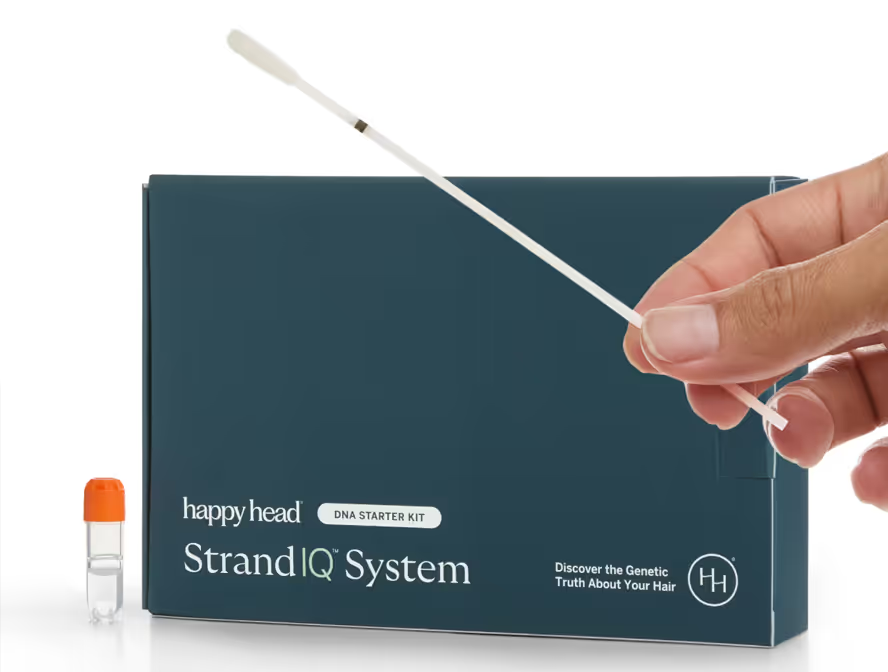Dutasteride is one of the most powerful treatments for male and female pattern hair loss. It blocks both types of the enzymes that turn testosterone into DHT—the hormone responsible for shrinking hair follicles and causing thinning over time. By lowering DHT, dutasteride can help slow hair loss, protect the hair you have, and, for some people, even encourage regrowth.
However, your genetic makeup plays a major role in how effectively your body processes this medication. Variants in genes that control drug metabolism—such as CYP3A4, CYP3A5, and SLCO1B1—can affect how quickly or slowly dutasteride is broken down and transported in the body. This means two people taking the same dose could experience very different results and side effect profiles.
Genetics and Dutasteride Metabolism
Dutasteride is primarily metabolized in the liver by CYP3A4 and CYP3A5, members of the cytochrome P450 family. These enzymes determine how rapidly the drug is broken down and cleared from the bloodstream.
- Rapid metabolizers may process the drug too quickly, leading to lower blood levels and reduced therapeutic benefit.
- Slow metabolizers may have higher drug concentrations for longer periods, increasing the risk of side effects such as reduced libido, erectile dysfunction, or breast tenderness.
Transport proteins like SLCO1B1 also help move dutasteride and its metabolites into and out of tissues. Variations here can impact how effectively the medication reaches the scalp and hair follicles.
By understanding your genetic profile, you and your healthcare provider can make more informed decisions about dosing strategies, monitoring, and whether dutasteride is the best choice for your specific type of hair loss.
Metabolization Levels and What They Mean
Your body’s ability to metabolize dutasteride depends on genetic variations that influence how quickly or effectively the drug is processed and utilized. These differences can affect how much active drug remains in your system, how well it binds to its target enzymes, and ultimately, how effective it is in reducing DHT levels that contribute to hair loss. Happy Head’s StrandIQ™ analysis helps you to understand your personal metabolization rate so that you and your doctor can fine-tune your dosage or explore complementary treatments for optimal results.
- Fast Metabolizer
Your genetics indicate that your body processes dutasteride quickly, which may lead to lower drug levels and reduced efficacy with standard dosing. - Normal Metabolizer
You process dutasteride at an average rate, comparable to most users, making standard dosing generally effective with good tolerance. - Slow Metabolizer
Your genetic profile suggests slower breakdown of dutasteride, which can lead to higher systemic exposure and an increased risk of side effects if dosing is not tailored.
Recommendations for Each Metabolization Level
Fast Metabolizer – Ensure Efficacy
- Consider dose frequency adjustments
Your Happy Head provider might recommend splitting your dose (e.g., taking half in the morning and half at night) or increasing frequency slightly under supervision to sustain therapeutic drug levels. - Monitor DHT levels and hair growth closely
Regular follow-ups can help confirm effectiveness and guide adjustments. - Combine with supportive treatments
Adding topicals like minoxidil or microneedling may enhance results if oral levels dip too quickly.
Normal Metabolizer – Follow Standard Protocols
- Use standard once-daily dosing
Since your metabolism is typical, standard protocols are usually sufficient for both effectiveness and safety. - Regular progress checks
Monitor hair density and function at 6- and 12-month intervals to track response. - Optional supportive pairing
You may benefit from adding low-level laser therapy or nutritional support to maximize regrowth potential.
Slow Metabolizer – Minimize Side-Effect Risk
- Start with a lower dose
Your Happy Head dermatologist may initiate a reduced starting dose to limit excess exposure. - Monitor for systemic effects
Because your body clears the drug more slowly, pay attention to side effects like libido changes or breast tenderness and discuss with your provider. - Consider alternative delivery
Options such as topical dutasteride or combination treatments to limit the need for oral dosing.
The Bottom Line
Understanding your dutasteride metabolizer status helps your physician craft a more precise and effective treatment plan—whether that means spacing doses, adjusting strength, or pairing with complementary therapies. This personalized approach maximizes results, minimizes risk, and ensures long-term hair health.
Resources
StrandIQ SNP Marker Count: 3
StrandIQ Genes for Trait:
CYP3A4, CYP4V2, CYP19A1
References:
Burns, O., et al. (2018). Relative bioavailability of fixed-dose combinations of tamsulosin and dutasteride: Results from 2 randomized trials in healthy male volunteers. Clinical Pharmacology Drug Development, 7(4), 422–434. PMID: 28800206.
Eriksson, A.L., et al. (2009). Genetic variations in sex steroid-related genes as predictors of serum estrogen levels in men. Journal of Clinical Endocrinology & Metabolism, 94(3), 1033–1041. PMID: 19116238.
Francès, M.P., et al. (2024). Utilising SNP association analysis as a prospective approach for personalising androgenetic alopecia treatment. Dermatology and Therapy (Heidelberg), 14(4), 971–981. PMID: 38555553.
Jiang, J., et al. (2010). Association of genetic variations in aromatase gene with serum estrogen and estrogen/testosterone ratio in Chinese elderly men. Clinica Chimica Acta, 411(1–2), 53–58. PMID: 19818337.
Makridakis, N.M., et al. (2000). Biochemical and pharmacogenetic dissection of human steroid 5 alpha-reductase type II. Pharmacogenetics, 10(5), 407–413. PMID: 10898110.
Rhie, A., et al. (2019). Genetic variations associated with response to dutasteride in the treatment of male subjects with androgenetic alopecia. PLoS One, 14(9), e0222533. PMID: 31525235.
Vila-Vecilla, L., Russo, V., de Souza, G.T. (2024). Genomic markers and personalized medicine in androgenetic alopecia: A comprehensive review. Cosmetics, 11(5), 148.
Villapalos-García, G., et al. (2021). Effects of cytochrome P450 and transporter polymorphisms on the bioavailability and safety of dutasteride and tamsulosin. Frontiers in Pharmacology, 12, 718281. PMID: 34690761.
Yeap, B.B., et al. (2019). A 5α-reductase (SRD5A2) polymorphism is associated with serum testosterone and sex hormone-binding globulin in men, while aromatase (CYP19A1) polymorphisms are associated with oestradiol and luteinizing hormone reciprocally. Clinical Endocrinology (Oxford), 90(2), 301–311. PMID: 30353958.
This content, including StrandIQ™ DNA analysis reports and any Happy Head products and/or services referenced therein, is for informational and cosmetic purposes only. It is not intended to diagnose, treat, cure, or prevent any disease. This content does not constitute medical advice and should not be used to make healthcare decisions. References to prescription treatments are educational in nature. Always consult a licensed healthcare professional for any medical concerns or treatment decisions.








.avif)

